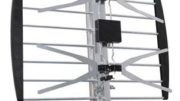Let’s say you’ve just moved to a new home. You want to go up on that roof, get an antenna up, and leave it. You don’t want to worry about anything, you just want to get it up and done. We’ve got the answer for you. The only question is how far you are from the broadcast towers. (This isn’t likely to change, it’s not like your house will move further away from a city all by itself.)
What do you need in order to be futureproof?
The world of broadcasting is always changing. In the next year, almost every TV channel in the country will change frequencies, again. Most of them changed just ten years ago. But, broadcasting is getting more efficient. In the 1940s channels had to be spaced very far apart. You couldn’t have two channels on adjacent frequencies or they would interfere with each other. So, even though the TV spectrum had up to 82 channels at one point, it would have been very hard to have more than 20 stations without interference.
Today, digital broadcasting means that broadcasts on adjacent channels aren’t a problem. Not only that, but you can have a lot of different programs on one broadcast channel. In a large city like Los Angeles, you can have over 100 program sources in just the 35 broadcast channels that are available, and still have channels left over.
In the future, in order to deal with a shrinking number of broadcast channels, you’ll need an antenna that gets all the channels, starting with channel 2. Some antennas are only good for channels 7 and up, while others only work on the UHF band from channels 14-36.
4K and other future services
Today’s antennas will work just fine for 4K over the air, if it even comes at all. The antenna doesn’t know if it’s picking up an old-school broadcast from 1955, a digital one from today, or a new-school broadcast in the future. The physics involved is the same. That’s why old TV antennas that have been on roofs longer than most folks have been alive will still work.
If you’re fewer than 45 miles from the towers
The best option here is an omnidirectional antenna because there’s no chance it will need to be reaimed, and the best one in our arsenal is the Antop UFO. It has the ability to pull in really weak signals and it just sits happily on the roof doing its job, year after year after year.
The UFO almost looks like a satellite dish turned sideways and it’s an excellent complement for a satellite dish too. If you have a dish on your roof that you’re not using, you can usually remove the dish part and use the existing mast and cables for an easy installation.
While the manufacturer rates the UFO at 60 miles, your specific performance will depend on any buildings or hills between you and the towers. I tell people this is an excellent 45 mile antenna and as far as any distance after that, it’s very likely but not guaranteed that you’ll be happy.
If you’re more than 45 miles from the towers
Sure. the Xtreme Signal HD8200XL is overkill. It’s a massive behemoth of an antenna and in a world where size matters, this antenna matters most.
Still, if you’re going up on that roof for the one and only time, overkill is precisely what you want. If the wind whips the antenna a degree or two off, this antenna’s so powerful it shouldn’t be a problem. Say a bird falls out of the sky or the neighbor kid hits a high fly ball… knocking out one of the elements. This antenna’s got power to spare! It’s hard to imagine anything actually getting to this antenna short of a hurricane and if you’re in that kind of weather, well let’s say TV reception may not be your first concern.
By the way, both of these antennas can get VHF and UHF signals, so no matter what happens in the future you’ll be safe.





